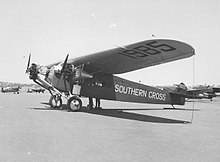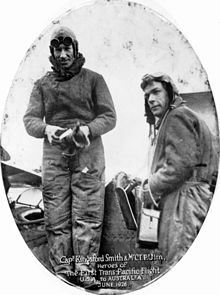
A transpacific flight is the flight of an aircraft across the Pacific Ocean from Australasia, East and Southeast Asia to North America, Latin America, or vice versa. Such flights have been made by fixed-wing aircraft, balloons and other types of aircraft.
Though less common than transatlantic flights, transpacific flights have been commercially available since the mid-1930s and have been used for transport of cargo and passengers across the Pacific Ocean. The time and distance of transpacific flights are longer than transatlantic flights, thanks to the much broader width of the Pacific. The first transpacific flight occurred in 1928, nine years after the first transatlantic flight in 1919.
History
In 1927, Ernie Smith and Emory Bronte attempted the first civilian transpacific flight bound for Maui, Hawaii starting from Oakland, California. The duo "flew 25 hours and two minutes at 6,000 feet in a single-engine Travel Air 5000 monoplane, but ran out of gas and safely crash-landed on Molokai". A memorial was constructed to mark "the historic end to the first civilian transpacific flight".
First transpacific flight



In 1928, Australian aviator Charles Kingsford Smith and his crew were the first to cross the Pacific by air. Smith and his relief pilot, fellow Australian Charles Ulm, arrived in the United States and began to search for an aircraft. Famed Australian polar explorer Sir Hubert Wilkins sold them a Fokker F.VII/3m monoplane, which they named the Southern Cross.
At 8:54 a.m. on 31 May 1928, Kingsford Smith and his crew left Oakland, California, to attempt the first trans-Pacific flight to Australia. The flight was in three stages. The first, from Oakland to Wheeler Army Airfield, Hawaii, was 3,870 kilometres (2,400 mi), taking an uneventful 27 hours 25 minutes (87.54 mph). They took off from Barking Sands on Mana, Kauai, since the runway at Wheeler was not long enough. They headed for Suva, Fiji, 5,077 kilometres (3,155 mi) away, taking 34 hours 30 minutes (91.45 mph). This was the most demanding portion of the journey, as they flew through a massive lightning storm near the equator. The third leg was the shortest, 2,709 kilometres (1,683 mi) in 20 hours (84.15 mph), and crossed the Australian coastline near Ballina before turning north to fly 170 kilometres (110 mi) to Brisbane, where they landed at 10:50 a.m. on 9 June. The total flight distance was approximately 11,566 kilometres (7,187 mi). Kingsford Smith was met by a huge crowd of 26,000 at Eagle Farm Airport, and was welcomed as a hero. While Australians Kingsford Smith (main) and Ulm (relief) were the pilots, the other two crewmen were Americans, radio operator James Warner, and Captain Harry Lyon, who was navigator and engineer.
The National Film and Sound Archive of Australia has a film biography of Kingsford Smith, called An Airman Remembers, and recordings of Kingsford Smith and Ulm talking about the journey.
Kingsford Smith's second flight
In early November 1934, Smith undertook a second transpacific flight. The 1928 transpacific flight took 27 hours and 28 minutes and his 1934 flight took 14 hours and 59 minutes. By this point seven pilots, one of them a woman, had died attempting transpacific flights.
First non-stop flight
On 5 October 1931, Clyde Pangborn, with co-pilot Hugh Herndon Jr, while piloting a Bellanca called Miss Veedol, crash-landed the plane in the hills of East Wenatchee, Washington, in the central part of the state, becoming the first people to fly non-stop across the northern Pacific Ocean. The 41-hour flight from Sabishiro Beach, Misawa, Aomori Prefecture, Japan, won them the 1931 Harmon Trophy, which symbolized the greatest achievement in flight for that year. The plane was "heavily modified to carry 930 US gallons (3,500 L) of fuel" and made without landing gear to save fuel.
Other attempts
In July 1929, Harold Bromley attempted to fly from Tacoma, Washington to Tokyo, Japan in an orange Lockheed Vega monoplane purchased by lumberman John Buffelen, who raised $25,000 to acquire the plane. The gasoline tanks were overfilled causing gasoline to pour onto the windshield and into Bromley's goggles temporarily blinding him. The plane crashed by the runway, Bromley was unhurt and would later try again to cross the Pacific Ocean.
Commercial flights
In 1935, the beginning of commercial transpacific flights to and from California began operation. On 22 November 1935, "Pan American Airlines' China Clipper launched its first transpacific flight, covering a distance of 8,000 miles (13,000 km)". A large "Martin M-130 seaplane departed from Alameda, in the Bay Area, and island-hopped to Oahu, Midway Island, Wake Island, Guam, and the Philippines before arriving in Canton, China, with a cargo of mail". A year later, passenger flights using the same route were inaugurated by Pan American. California became the undisputed national leader of transpacific flights. For the next year, Pan American planned for passenger flights, the China Clipper and its sister ships, the Philippine Clipper and Hawaii Clipper, focused on cargo transport including mail across the Pacific during this time. The route was ready for passenger service by October 1936.
Records
In November 1981, the first successful transpacific balloon crossing was made in the balloon Double Eagle V. It launched from Nagashima, Japan on November 10, 1981, and landed in Mendocino National Forest in California 84 hours and 31 minutes later, covering a record 9,283 kilometres (5,768 mi). The four-man crew consisted of Albuquerque balloonists Ben Abruzzo, Larry Newman, and Ron Clark, and thrill-seeking restaurateur Rocky Aoki, who helped fund the flight. After crossing the Pacific the helium-filled Double Eagle V, weighed down by ice and buffeted by a storm, crash-landed in northern California, ending the nearly 10,000-kilometre (6,000 mi) flight. No one was hurt.
On February 21, 1995, aviator Steve Fossett was the first person to make a solo flight across the Pacific Ocean in a balloon from South Korea to Leader, Saskatchewan.
On 25 January 2015, pilots Troy Bradley and Leonid Tiukhtyaev flying the Two Eagles Balloon, surpassed the Double Eagle II duration record and Double Eagle V distance record after traveling 9,777 kilometres (6,075 mi) across the Pacific.
In 2015 and 2016, Solar Impulse 2 made a transpacific crossing while attempting to circumnavigate the world. The plane landed in Mountain View, California after three days of continuous flying from Hawaii. The pilots only slept 20 minutes at a time, and the plane's cockpit had no heating or air conditioning. The plane was piloted by two Swiss pilots: Bertrand Piccard, a psychiatrist, and André Borschberg, an engineer and entrepreneur.
See also
References
- Carroll, Marcie; Carroll, Rick (2009). The Unofficial Guide to Maui (4 ed.). New York: Wiley. pp. 173–174. ISBN 978-0-470-37998-1. Retrieved 19 October 2019.
- ^ "7.30 report story about Charles Ulm". ABCnet.au. 31 May 1928. Archived from the original on 4 March 2016. Retrieved 21 September 2009.
- "Charles Kingsford-Smith – Hawaii Aviation". Hawaii.gov. Archived from the original on 2 October 2015.
- "The Great Pacific Flight". Flight. 20 (1016): 437. 14 June 1928. Archived from the original on 2 November 2013. Retrieved 31 August 2013.
- Kingsford-Smith, Charles; C. T. P. Ulm (1928). Story of "Southern Cross" Trans-Pacific Flight, 1928. Sydney: Penlington and Somerville.
- "Ballina Aero Club". Ballina Aero Club. 9 June 1928. Archived from the original on 9 April 2013.
- "Far North Coaster". Far North Coaster. 23 May 2008. Archived from the original on 3 November 2013. Retrieved 17 March 2012.
- Aviators - Charles Kingsford-Smith Archived 15 April 2014 at the Wayback Machine - (includes photo of the plaque commemorating the flight across the Pacific and the landing at Brisbane on 9 June 1928)
- "Brisbane - Eagle Farm - History of Eagle Farm - ourbrisbane.com". 24 January 2004. Archived from the original on 24 January 2004. Retrieved 20 March 2018.
- Photo of Southern Cross, and welcoming crowd, at Eagle Farm on 9 June 1928 (National Archives of Australia)
- "Magnificent Machines – Home-grown Legends (Sydney Morning Herald)". The Sydney Morning Herald. 17 December 2003. Archived from the original on 20 October 2012.
- Lyon, Harry W. Captain; Kingsford-Smith, Charles Sir, 1897-1935; Warner, James. (Interviewee); 2GB (Radio station : Sydney, N.S.W.) (1958), Reminiscences of flights in the "Southern Cross", retrieved 2 February 2017
{{citation}}: CS1 maint: multiple names: authors list (link) CS1 maint: numeric names: authors list (link) - National Film and Sound Archive of Australia: 'An Airman Remembers' Archived 5 December 2011 at the Wayback Machine on australianscreen online Archived 2 March 2011 at the Wayback Machine
- National Film and Sound Archive of Australia: 'Our Heroes of the Air' Archived 31 January 2012 at the Wayback Machine
- Butler, Susan (1999). East to the Dawn: The Life of Amelia Earhart. New York: Da Capo Press. ISBN 978-0-7867-4579-1. Retrieved 19 October 2019.
- "Clyde Pangborn and Hugh Herndon, Jr.: First to Fly Nonstop Across the Pacific (p 5)". Weider History Group. 2006. Retrieved 1 August 2011.
- Stratton, Benjamin J. (25 August 2017). "First transpacific flight creates Washington, Misawa bond". United States Air Force. Archived from the original on 19 October 2019. Retrieved 19 October 2019.
- Paur, Jason (5 October 2010). "Oct. 5, 1931: First Nonstop Trans-Pacific Flight Ends in Cloud of Dust". Wired. Retrieved 19 October 2019.
- Goldstein, Richard (11 January 1998). "Harold Bromley, Aviator Lacking Lindbergh's Luck, Dies at 99". The New York Times. Retrieved 2 January 2020.
- Osborne, Thomas J. (2013). Pacific Eldorado: A History of Greater California. Chichester, West Sussex: Wiley. pp. 251–252. ISBN 978-1-4051-9454-9. Retrieved 19 October 2019.
- Romanowski, David (14 July 2014). "The First Transpacific Passenger Flight". National Air and Space Museum. Archived from the original on 19 October 2019. Retrieved 19 October 2019.
- Nelson, Ray (1985). Flight of the Pacific Eagle. Albuquerque: Transpac.
- "Ron Clark Died: September 26, 2010 Location: Albuquerque, New Mexico". Evans.tributes.com. Evans Tributes. Retrieved 20 June 2020.
- Marsh, Carole (1994). The Hawaii Hot Air Balloon Mystery. Gallopade International. p. 40. ISBN 978-0-7933-2418-7. Retrieved 19 October 2019.
- "Aviation Adventurer Steve Fossett Missing". CBS News. September 4, 2007. Archived from the original on April 25, 2009. Retrieved March 13, 2010.
- ^ Specia, Megan (30 January 2015). "Balloon pilots burst records with transpacific flight". Mashable. Archived from the original on 19 October 2019. Retrieved 19 October 2019.
- "Balloonists set records crossing Pacific". Retrieved 30 January 2015.
- Shekhtman, Lonnie (24 April 2016). "Solar-powered aircraft, Solar Impulse 2, completes trans-Pacific flight". Christian Science Monitor. Archived from the original on 19 October 2019. Retrieved 19 October 2019.
- "Solar-plane pilots say trans-Pacific trip was also test of human endurance". Los Angeles Times. Associated Press. 24 April 2016. Archived from the original on 19 October 2019. Retrieved 19 October 2019.
External links
- First transpacific passenger flight
- Image of Zensaku Azuma next to the plane he flew from the United States to Tokyo, 1930. Los Angeles Times Photographic Archive (Collection 1429). UCLA Library Special Collections, Charles E. Young Research Library, University of California, Los Angeles.